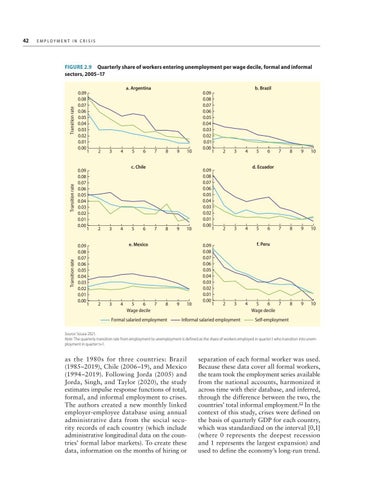Employment in Crisis
Transition rate
Transition rate
FIGURE 2.9 Quarterly share of workers entering unemployment per wage decile, formal and informal sectors, 2005–17
Transition rate
42
0.09 0.08 0.07 0.06 0.05 0.04 0.03 0.02 0.01 0.00
0.09 0.08 0.07 0.06 0.05 0.04 0.03 0.02 0.01 0.00
0.09 0.08 0.07 0.06 0.05 0.04 0.03 0.02 0.01 0.00
a. Argentina
1
2
3
4
5
6
7
8
9
10
c. Chile
1
2
3
4
5
6
7
8
9
10
e. Mexico
1
2
3
4
5 6 7 Wage decile
8
Formal salaried employment
9
10
0.09 0.08 0.07 0.06 0.05 0.04 0.03 0.02 0.01 0.00 1
0.09 0.08 0.07 0.06 0.05 0.04 0.03 0.02 0.01 0.00
0.09 0.08 0.07 0.06 0.05 0.04 0.03 0.02 0.01 0.00
b. Brazil
2
3
4
5
6
7
8
9
10
7
8
9
10
5 6 7 Wage decile
8
9
10
d. Ecuador
1
2
3
4
5
6
f. Peru
1
2
3
Informal salaried employment
4
Self-employment
Source: Sousa 2021. Note: The quarterly transition rate from employment to unemployment is defined as the share of workers employed in quarter t who transition into unemployment in quarter t+1.
as the 1980s for three countries: Brazil (1985–2019), Chile (2006–19), and Mexico (1994–2019). Following Jorda (2005) and Jorda, Singh, and Taylor (2020), the study estimates impulse response functions of total, formal, and informal employment to crises. The authors created a new monthly linked employer-employee database using annual administrative data from the social security records of each country (which include administrative longitudinal data on the countries’ formal labor markets). To create these data, information on the months of hiring or
separation of each formal worker was used. Because these data cover all formal workers, the team took the employment series available from the national accounts, harmonized it across time with their database, and inferred, through the difference between the two, the countries’ total informal employment.12 In the context of this study, crises were defined on the basis of quarterly GDP for each country, which was standardized on the interval [0,1] (where 0 represents the deepest recession and 1 represents the largest expansion) and used to define the economy’s long-run trend.

